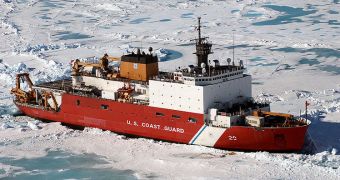Researchers at the United States Geological Survey (USGS) are very interested in establishing how trends in ocean acidification fare over time. To that end, they are about to embark on a new scientific expedition, this time to the Arctic Ocean.
The US Coast Guard made its cutter vessel Healy available to USGS scientists, who will be heading towards the Arctic on August 15. Once they arrive in the region, the latter will sample ocean water from a large number of locations, so as to get the most accurate results.
The information will help them form a more in-depth view of how oceanic acidification is evolving. This process is largely caused by carbon dioxide emissions in the atmosphere. The same CO2 emissions are also responsible for global warming.
Acidification occurs when CO2 interacts with water. The oceans have a natural mechanism of storing carbon at the bottom, via phytoplankton. However, excessive amounts of the greenhouse gas cannot be removed as efficiently, so they interact chemically with the water.
This leads to the production of carbonic acid, which is what is driving oceanic acidification as a whole. What the USGS team wants to learn is how this process occurs near the North Pole, and at what speed.
“The Arctic Ocean is one of the most vulnerable areas for ocean acidification on our planet but there is very little data and understanding about current acidification trends and potential impacts to oceanic food chains in the region,” expert Lisa Robbins says.
“This research should provide us with greater insight into this growing climatic concern,” adds the scientist, who holds an appointment as an oceanographer at the USGS. She is also a member of the team that will embark on the Healy soon.
This new research effort – currently at its second iteration – is being conducted as part of the 2011 US – Canada Extended Continental Shelf Survey expedition. The latter is a collaborative effort between the USCG, the USGS, and the Canadian Coast Guard.
“Sampling from a variety of environments and depths in the Arctic will provide a robust data set that we can use to compare our techniques as well as give us an overall picture of ocean chemistry changes throughout the water column,” USGS oceanographer Kim Yates explains.
“Ocean acidification can have broad global impacts on industry, ecosystems, tourism, and policy, so it is of vital importance to determine trends and whether impacts are already occurring in oceans around the world,” Robbins goes on to say.
Oceanic acidification can lead to impairing calcifying organisms' ability to build skeletons and shells, a phenomenon that affects numerous species, ranging from shrimp to corals. This has the ability to hamper food webs spanning the entire world ocean.

 14 DAY TRIAL //
14 DAY TRIAL //